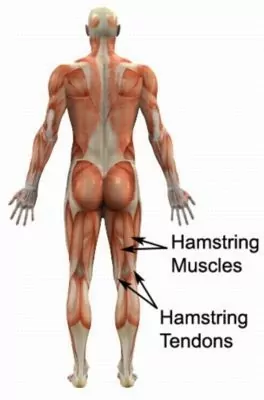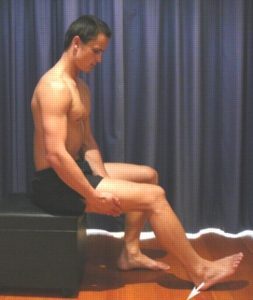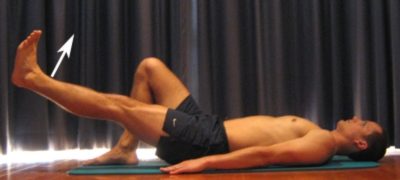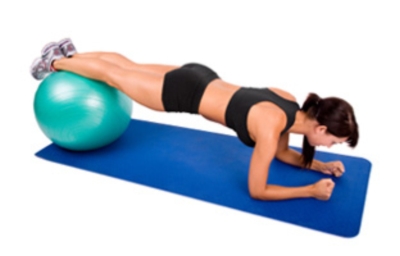Hamstring Tendonitis
Updated:
(Also known as Hamstring Tendinopathy, Hamstring Tendinitis, Biceps Femoris Tendinopathy)
N.B. Although research suggests that ‘hamstring tendinopathy’ is the more appropriate term to describe overuse injuries to the hamstring tendon, we will use the term ‘hamstring tendonitis’ in this document as it is more widely known.
What is hamstring tendonitis?
Hamstring tendonitis is a condition characterized by tissue damage and inflammation to one or more of the hamstring tendons. This occurs at their attachment to the top of the lower leg causing pain in the back of the knee.
The hamstring muscles originate from the pelvis and insert into the top of the lower leg bones (tibia and fibula). The hamstring muscles comprise of 3 muscle bellies: the biceps femoris (outer hamstring) and the semimembranosus and semitendinosus (inner hamstring).The hamstring muscles attach to the outer and inner aspect of the lower leg bones via the hamstring tendons (figure 1).

The hamstring muscles are responsible for bending the knee and straightening the hip during activity and are particularly active during running, jumping and kicking. During contraction of the hamstrings, tension is placed through the hamstring tendons. When this tension is excessive due to too much repetition or high force, damage to the hamstring tendons may occur. Hamstring tendonitis is a condition whereby there is damage to one or more of the hamstring tendons with subsequent degeneration and inflammation.
Causes of hamstring tendonitis
Hamstring tendonitis most commonly occurs due to repetitive or prolonged activities placing strain on one or more hamstring tendons. This typically occurs due to repetitive running, jumping or kicking activities. It is also particularly common in sports requiring frequent acceleration and deceleration such as football and soccer.
Occasionally, patients may develop this condition suddenly due to a high force going through the hamstring tendons beyond what they can withstand. This most commonly occurs during rapid acceleration whilst running or when a footballer performs a long kick, particularly following an inadequate warm-up.
Signs and symptoms of hamstring tendonitis
Patients with hamstring tendonitis typically experience pain that develops gradually in the inner or outer aspect of the back of the knee. Pain may also radiate into the top of the calf or back of the thigh. In less severe cases, patients may only experience an ache or stiffness in the knee that increases with rest following activities requiring strong or repetitive contraction of the hamstring muscle. These activities typically include running, jumping or kicking. The pain associated with this condition may also warm up with activity in the initial stages of the condition.
As the condition progresses, patients may experience symptoms that increase during activity and affect performance. Patients with this condition typically experience pain on firmly touching the hamstring tendons (figure 1). Occasionally, a feeling of lower limb weakness may also be present particularly when attempting to accelerate whilst running.
Diagnosis of hamstring tendonitis
A thorough subjective and objective examination from a physiotherapist is usually sufficient to diagnose hamstring tendonitis. Occasionally, further investigations such as an Ultrasound, X-ray, MRI or CT scan may be required to assist with diagnosis and assess the severity of the condition.
Prognosis of hamstring tendonitis
Most patients with this condition heal well with appropriate physiotherapy and return to normal function in a number of weeks. Occasionally, rehabilitation can take significantly longer and may take many months in those who have had their condition for a long period of time. Early physiotherapy treatment is vital to hasten recovery in all patients with this condition.
Treatment for hamstring tendonitis

Members Only ContentBecome a PhysioAdvisor Member to gain full access to this exclusive content. For more details see Become a Member. Already a member? Login Now
Contributing factors to the development of hamstring tendonitis
There are several factors which can predispose patients to developing this condition. These need to be assessed and corrected with direction from a physiotherapist. Some of these factors include:
- joint stiffness (particularly the hip, knee and lower back)
- muscle tightness (particularly the hamstrings and quadriceps)
- inappropriate or excessive training
- inadequate warm up
- muscle weakness (especially the hamstrings and gluteals)
- poor pelvic or core stability
- inadequate rehabilitation following a previous hamstring injury
- poor biomechanics
- decreased fitness
- neural tightness
- being overweight
Physiotherapy for hamstring tendonitis
Physiotherapy treatment for patients with hamstring tendonitis is vital to hasten the healing process, ensure an optimal outcome and reduce the likelihood of injury recurrence. Treatment may comprise:
- soft tissue massage
- electrotherapy (e.g. ultrasound)
- stretches
- joint mobilization
- dry needling
- ice or heat treatment
- the use of crutches
- exercises to improve strength, flexibility and core stability
- education
- anti-inflammatory advice
- biomechanical correction
- activity modification advice
- a gradual return to activity program
Other intervention for hamstring tendonitis
Despite appropriate physiotherapy management, some patients with this condition do not improve adequately. When this occurs the treating physiotherapist or doctor will advise on the best course of management. This may include further investigations such as X-rays, ultrasound, MRI or CT scan, pharmaceutical intervention, corticosteroid injection, autologous blood injection or referral to appropriate medical authorities who will advise on any interventions that may be appropriate to improve the condition.
Exercises for hamstring tendonitis
The following exercises are commonly prescribed to patients with this condition. You should discuss the suitability of these exercises with your physiotherapist prior to beginning them. Generally, they should be performed provided they do not cause or increase symptoms.
Initial Exercises
Static Hamstring Contraction
Begin this exercise in sitting with your knee bent to about 45 degrees (figure 2). Press your heel into the floor tightening the back of your thigh (hamstrings). Hold for 5 seconds and repeat 10 times as hard as possible and comfortable, pain free. Perform 1 – 3 times daily provided there is no increase in symptoms.

Straight Leg Raise
Begin this exercise lying on your back with your injured leg straight and your good leg bent (figure 3). Slowly lift your straight leg until you feel a mild to moderate stretch or as far as possible and comfortable without increasing symptoms. Hold for 2 seconds and then slowly lower. Repeat 10 times 1 – 3 times daily provided there is no increase in symptoms.

Intermediate Exercises

Members Only ContentBecome a PhysioAdvisor Member to gain full access to this exclusive content. For more details see Become a Member. Already a member? Login Now
Advanced Exercises

Members Only ContentBecome a PhysioAdvisor Member to gain full access to this exclusive content. For more details see Become a Member. Already a member? Login Now
Rehabilitation Protocol

Members Only ContentBecome a PhysioAdvisor Member to gain full access to this exclusive content. For more details see Become a Member. Already a member? Login Now
 Physiotherapy products for hamstring tendonitis
Physiotherapy products for hamstring tendonitis
Some of the most commonly recommended products by physiotherapists to hasten healing and speed recovery in patients with this condition include:
To purchase physiotherapy products for hamstring tendonitis click on one of the above links or visit the PhysioAdvisor Shop.
 Find a Physio
Find a Physio
Find a physiotherapist in your local area who can treat hamstring tendonitis.
 More Information
More Information
- View detailed information on How to use Crutches.
- View detailed information on when to use Ice or Heat.
- View detailed information on initial injury management and the R.I.C.E. regime.
- View detailed information on a Return to Running Program.
- View detailed information on Do I Need Orthotics?
- View detailed information on Returning to Sport.
- Read our Knee Diagnosis Guide.
 Other exercises
Other exercises
- View more Hamstring Flexibility Exercises.
- View more Hamstring Strengthening Exercises.
- View more Leg Stretches.
- View more Leg Strengthening Exercises.
- View Balance Exercises
- View Beginner Pilates Exercises to improve core stability and posture.
Become a PhysioAdvisor Member

Link to this Page
If you would like to link to this article on your website, simply copy the code below and add it to your page:
<a href="https://physioadvisor.com.au/injuries/knee/hamstring-tendonitis”>Hamstring Tendonitis – PhysioAdvisor.com</a><br/>PhysioAdvisor offers detailed physiotherapy information on hamstring injuries and hamstring tendonitis including: signs and symptoms, diagnosis, treatment, exercises and physiotherapy products.
Return to the top of Hamstring Tendonitis.











